Primary Mathematics Chapter 3 Fractions
Page 91 Exercise 3.4 Problem 1
Given: Expression \(\frac{4}{5}\)–\(\frac{1}{5}\)= ______
Question is to find the difference between the given numbers.
Subtraction of a fractional number can be done by making their denominators same.
As the denominators are same here, just by adding directly, answers can be obtained.
The answer can be obtained by analyzing the given figure also.
The difference can be found by subtracting the numerators directly as the denominators are same.
⇒ \(\frac{4}{5}\)–\(\frac{1}{5}\)
⇒ \(\frac{4}{5}\)–\(\frac{1}{5}\)= \(\frac{3}{5}\)
So the difference between given numbers is found to be \(\frac{3}{5}\)
Also, by analyzing the figure, out of4 shaded part, 1 is subtracted. So, 3 shaded parts out of 5 parts remains.
Therefore, solution for the given expression=_______ is \(\frac{3}{5}\).
Page 91 Exercise 3.4 Problem 2
Given: Expression \(\frac{4}{6}\)–\(\frac{3}{6}\)= \(\frac{3}{5}\)= ______
Question is to find the difference between the given numbers.
Subtraction of a fractional number can be done by making their denominators same.
As the denominators are same here, just by adding directly, answers can be obtained.
The answer can be obtained by analyzing the given figure also.
The difference can be found by subtracting the numerators directly as the denominators are same.
⇒ \(\frac{4}{6}\)–\(\frac{3}{6}\)= \(\frac{3}{5}\)= \(\frac{4-3}{6}\)
⇒ \(\frac{4}{6}\)–\(\frac{3}{6}\)= \(\frac{3}{5}\)= \(\frac{1}{6}\)
Therefore, solution for the given expression \(\frac{4}{6}\)− \(\frac{3}{6}\)=____ is \(\frac{3}{5}\)= \(\frac{1}{6}\).
Page 91 Exercise 3.4 Problem 3
Given: Expression \(\frac{5}{8}\)–\(\frac{2}{8}\)=____
Question is to find the difference between the given numbers.
Subtraction of a fractional number can be done by making their denominators same.
As the denominators are same here, just by adding directly, answers can be obtained.
The answer can be obtained by analyzing the given figure also.
The difference can be found by subtracting the numerators directly as the denominators are same.
⇒ \(\frac{5}{8}\)–\(\frac{2}{8}\)= =\(\frac{5-2}{8}\)
⇒ \(\frac{5}{8}\)–\(\frac{2}{8}\)= =\(\frac{3}{8}\)
So the difference between given numbers is found to be\(\frac{3}{8}\)
Also, by analyzing the figure, out of 5 shaded part, 2 is subtracted. So, 3 shaded parts out of 8 parts remains.
Therefore, solution for the given expression \(\frac{5}{8}\)–\(\frac{2}{8}\)=_____ is \(\frac{5-2}{8}\).
Page 91 Exercise 3.4 Problem 4
Given: Expression \(\frac{7}{10}\)–\(\frac{4}{10}\)=____
Question is to find the difference between the given numbers.
Subtraction of a fractional number can be done by making their denominators same.
As the denominators are same here, just by adding directly, answers can be obtained.
The answer can be obtained by analyzing the given figure also.
The difference can be found by subtracting the numerators directly as the denominators are same.
⇒ \(\frac{7}{10}\)–\(\frac{4}{10}\)=\(\frac{7-4}{10}\)
⇒ \(\frac{7}{10}\)–\(\frac{4}{10}\)=\(\frac{3}{10}\)
So the difference between given numbers is found to be \(\frac{3}{10}\)
Also, by analyzing the figure, out of 7 shaded parts, 4 is subtracted. So, 3 shaded parts out of 10 parts remains.
Therefore, solution for the given expression ⇒ \(\frac{7}{10}\)−\(\frac{4}{10}\)=____ is \(\frac{3}{10}\)
Page 92 Exercise 3.4 Problem 5
Given: A set of additions and a figure.
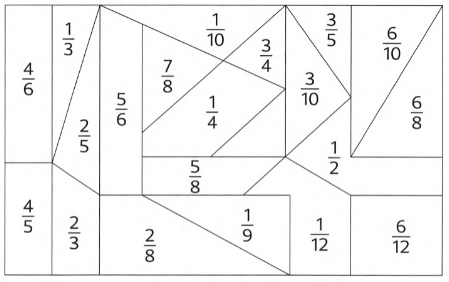
Question is to color the given figures that contain the answers of the given Subtractions.
Subtraction of a fractional number can be done by making their denominators same.
As the denominators are same here, just by Subtracting directly, answers can be obtained.
Subtraction of the given expression can be done as
1)\(\frac{2}{3}-\frac{1}{3}\)=\(\frac{1}{3}\)
2)\(\frac{4}{5}-\frac{2}{5}\)=\(\frac{4}{5}\)
3)\(\frac{5}{6}-\frac{1}{6}\)=\(\frac{4}{6}\)
4)\(\frac{7}{8}-\frac{2}{8}\)=\(\frac{5}{8}\)
5)\(\frac{5}{8}-\frac{3}{8}\)=\(\frac{2}{8}\)
6)\(\frac{7}{8}-\frac{1}{8}\)=\(\frac{6}{8}\)
7)\(\frac{9}{10}-\frac{3}{10}\)=\(\frac{6}{109}\)
8)\(\frac{7}{10}-\frac{4}{10}\)=\(\frac{3}{10}\)
9)\(\frac{7}{12}-\frac{6}{12}\)=\(\frac{1}{12}\)
So, the answers of the given subtractions are\(\frac{1}{3}\),\(\frac{4}{5}\),\(\frac{4}{6}\),\(\frac{5}{8}\),\(\frac{2}{8}\),\(\frac{6}{8}\),\(\frac{6}{109}\), and \(\frac{1}{12}\)
Now, the two times seven can be found by coloring the figures that contain the answers.
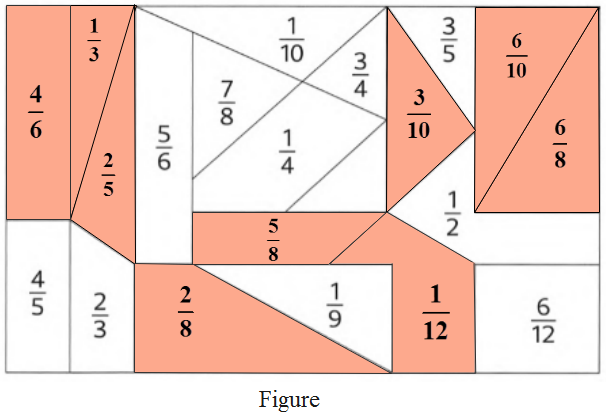
From the figure, after coloring, the number appearing is 14. So, two times seven is 14
Therefore, the answers in their simplest form for the given expressions are \(\frac{1}{3}\),\(\frac{4}{5}\),\(\frac{4}{6}\),\(\frac{5}{8}\),\(\frac{2}{8}\),\(\frac{6}{8}\),\(\frac{6}{109}\), and \(\frac{1}{12}\) respectively. After coloring the figures that contain the answers, two times seven is obtained as 14.
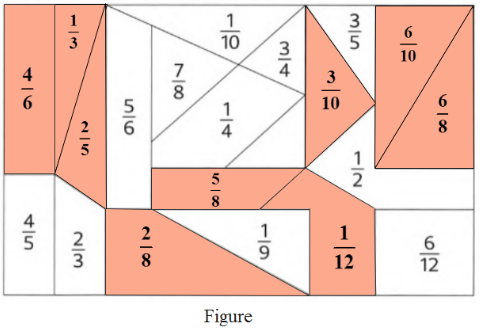
Page 93 Exercise 3.4 Problem 6
Given: Expression \(1-\frac{1}{4}-\frac{1}{4}\)=________
Question is to find the difference between the given numbers.
Subtraction of a fractional number can be done by making their denominators same.
As the denominators are not same here, by finding the LCM and making the denominator same, answers can be obtained.
The answer can be obtained by analyzing the given figure also.
As denominators are different, LCM is needed to make the denominator same.
LCM = 1×4
LCM = 4 Then the numbers will become
\(\frac{1 \times 4}{1 \times 4}-\frac{1}{4}-\frac{1}{4}\)=_______
Now, the difference can be found by subtracting the numerators directly as the denominators are same.
⇒ \(\frac{4}{4}-\frac{1}{4}-\frac{1}{4}\)= \(\frac{4-1-1}{4}\)
⇒ \(\frac{4}{4}-\frac{1}{4}-\frac{1}{4}\)= \(\frac{2}{4}\)
⇒ \(\frac{4}{4}-\frac{1}{4}-\frac{1}{4}\)= \(\frac{1}{2}\)
So the difference between given numbers is found to be \(\frac{1}{2}\)
Therefore, the solution for the given expression 1−1 \(1-\frac{1}{4}-\frac{1}{4}\)=________in its shortest form is \(\frac{1}{2}\)
Page 93 Exercise 3.4 Problem 7
Given: Expression 1-\(\frac{3}{5}\)=_______
Question is to find the difference between the given numbers.
Subtraction of a fractional number can be done by making their denominators same.
As the denominators are not same here, by finding the LCM and making the denominator same, answers can be obtained.
The answer can be obtained by analyzing the given figure also.
As d e nominators are different, LCM is needed to make the denominator same.
LCM = 1 ×5
LCM = 5
Then the numbers will become
\(\frac{1 \times 5}{1 \times 5}-\frac{3}{5}\)=_______
Now, the difference can be found by subtracting the numerators directly as the denominators are same.
⇒ \(\frac{5}{5}-\frac{3}{5}\)=\(\frac{5-3}{5}\)
⇒ \(\frac{5}{5}-\frac{3}{5}\)=\(\frac{2}{5}\)
So the difference between given numbers is found to be \(\frac{5}{5}-\frac{3}{5}\)=\(\frac{2}{5}\).
Therefore, the solution for the given expression \(\frac{1 \times 5}{1 \times 5}-\frac{3}{5}\)=_______in its shortest form is \(\frac{2}{5}\)
Page 93 Exercise 3.4 Problem 8
Given: Expression\(\frac{4}{5}\)−\(\frac{3}{5}\)−\(\frac{1}{5} \)=______
Question is to find the difference between the given numbers.
Subtraction of a fractional number can be done by making their denominators same.
As the denominators are same here, just by adding directly, answers can be obtained.
The answer can be obtained by analyzing the given figure also.
The difference can be found by subtracting the numerators directly as the denominators are same.
⇒ \(\frac{4}{5}−\frac{3}{5}\)−\(\frac{1}{5}\)= \(\frac{4-3-1}{5}\)
⇒ \(\frac{4}{5}−\frac{3}{5}\)−\(\frac{1}{5}\)= \(\frac{0}{5}\)
⇒ \(\frac{4}{5}−\frac{3}{5}\)−\(\frac{1}{5}\) = 0
So the difference between given numbers is found to be 0.
Therefore, the solution for the given expression \(\frac{4}{5}−\frac{3}{5}\)−\(\frac{1}{5}\)=______ in its shortest form is
Page 93 Exercise 3.4 Problem 9
Given: Gwen bought 1 kg of potatoes in which she used \(\frac{4}{7}\) Kg to make some potasto salad and another \(\frac{2}{7}\) Kg to make some mashed potato.
Question is to find how many kilograms of potatoes she have left and write the answer in its simplest form.
By subtracting the used potatoes from total potatoes bought will give the required answer.
Subtraction of a fractional number can be done by making their denominators same.
As the denominators are not same here, by finding the LCM and making the denominator same, answers can be obtained.
Now, to make some mashed potato, Gwen uses\(\frac{2}{7}\) Kg out of the remaining\(\frac{3}{7}\) Kg of potatoes left.
Then, net potatoes left can be obtained by subtracting potatoes used for making mashed potatoes from potatoes left after making salad.
⇒ \(\frac{3}{7}\) − \(\frac{2}{7}\)= \(\frac{1}{7}\)
So, the total potatoes left is \(\frac{1}{7}\) kg.
Page 94 Exercise 3.5 Problem 1
In the problem, the figure is given with a note 3 wholes 1 half
It is required to write a mixed number.
As it is given there are 3 wholes and 1 half.
This can be written as,
1+1+1+\(\frac{1}{2}\)= 3 + \(\frac{1}{2}\)
The mixed number obtained for 3 wholes and 1 half is 3 \(\frac{1}{2}\)
Page 94 Exercise 3.5 Problem 2
In the problem, the figure is given with note 2 wholes 4 fifths.
It is required to write a mixed number.
As it is given there are 2 wholes and 4 fifths.
This can be written as
1+1+\(\frac{4}{5}\)= 2+\(\frac{4}{5}\)
= 2\(\frac{4}{5}\)
The mixed number obtained for 2 wholes and 4 fifths is 2\(\frac{4}{5}\)
Page 94 Exercise 3.5 Problem 3
In the problem, the figure is given with note 2 wholes 4 fifths.
It is required to write a mixed number.
As it is given there are 2 wholes and 4 fifths.
This can be written as
1+1+\(\frac{4}{5}\)= 2+\(\frac{4}{5}\)
= 2 \(\frac{4}{5}\)
The mixed number obtained for 2 wholes and 4 fifths is 2 \(\frac{4}{5}\).
Page 94 Exercise 3.5 Problem 4
In the problem, the figure is given with a note 2 wholes 1 sixth.
It is required to write a mixed number.
As it is given there are 2 wholes and 1 sixth.
This can be written as
1+1+\(\frac{1}{6}\)= 2+\(\frac{1}{6}\)
= 2\(\frac{1}{6}\)
The mixed number obtained for 2 wholes and 1 sixth is 2\(\frac{1}{6}\)
Page 94 Exercise 3.5 Problem 5
In the problem, the figure is given with a note 3 wholes 7 eighths.
It is required to write a mixed number
As it is given there are 3 wholes an6 7 eighths.
This can be written as
1+1+1+\(\frac{7}{8}\)= 3+\(\frac{7}{8}\)
= 3\(\frac{7}{8}\)
The mixed number obtained for 3 wholes and 7 eighths is 3\(\frac{7}{8}\)
Page 95 Exercise 3.5 Problem 6
In the problem, a figure is with 3 strings and their lengths are given.
It is required to fill the blanks with a length of string B and C.
So solve this, first consider string B there are 1 whole and 3 fifth.
This can be written as
1+ \(\frac{3}{5}\)= 1\(\frac{3}{5}\)
Consider string C there are 2 wholes and 2 fifth.
This can be written as
1 + 1 + \(\frac{2}{5}\)= 2\(\frac{2}{5}\).
The length of B is 1\(\frac{3}{5}\)M, The length of C is 2\(\frac{2}{5}\)
Page 95 Exercise 3.5 Problem 7
In the problem, a figure is given where 3 wholes and 1fifth liters are represented.
It is required to find the total amount of water.
As it is given there are 3 wholes and 1 fifth liter.
This can be written as a mixed number
1+1+1+\(\frac{1}{5}\)= 3+\(\frac{1}{5}\)
= 3\(\frac{1}{5}\)
The total amount of water is 3\(\frac{1}{5}\)
Page 95 Exercise 3.5 Problem 8
In the problem, a figure with a note 2+\(\frac{3}{4}\)is given
It is required to fill the blanks, find 2+\(\frac{3}{4}\)
As it is given, 2 wholes and 3 fourth will give a mixed number
2 + \(\frac{3}{4}\) = 2\(\frac{3}{4}\)
For given 2 + \(\frac{3}{4}\), the mixed number is obtained 2\(\frac{3}{4}\)
Page 95 Exercise 3.5 Problem 9
In the problem, a figure with a note 3-\(\frac{1}{3}\) is given.
It is required to fill the blanks, find 3-\(\frac{1}{3}\).
As it is given, 2 wholes and 2 third will give a mixed number 1 + 1 + \(\frac{2}{3}\)= 2\(\frac{2}{3}\) that means,
3 – \(\frac{1}{3}\) = 2\(\frac{2}{3}\)
For the given 3-\(\frac{1}{3}\) the mixed number is obtained as 2\(\frac{2}{3}\).
Page 97 Exercise 3.6 Problem 1
In the problem, a figure is given where 2 wholes and 5 sixths are represented.
It is required to write a mixed number and an improper fraction.
To solve this, there are 2 wholes and 5 sixths.
This can be written as
1 + 1 + \(\frac{5}{6}\)= 2+\(\frac{5}{6}\)
= 2\(\frac{5}{6}\)
As it is given there are 2 wholes and 5 sixths.
The count of the total shaded portion will give the numerator and the number of separations made in one single shape will give the denominator.
Here the numerator is 17 and the denominator is 6 so the improper fraction is \(\frac{17}{6}\)
The mixed number obtained for 2 wholes and 5 sixths is 2\(\frac{5}{6}\) and the improper fraction obtained is \(\frac{17}{6}\)
Page 97 Exercise 3.6 Problem 2
In the problem, a figure is given where 2 wholes and 4 ninths are represented.
It is required to write a mixed number and an improper fraction.
To solve this, there are 2 wholes and 4 ninths.
The mixed number can be written as
1 + 1 + \(\frac{4}{9}\) = 2 + \(\frac{4}{9}\)
= 2\(\frac{4}{9}\)
As it is given there are 2 wholes and 4 ninths.
The count of the total shaded portion will give the numerator and the number of separations made in one single shape will give the denominator.
Here the numerator is 22 and the denominator is 9 so the improper fraction is\(\frac{22}{9}\).
The mixed number obtained for 2 wholes and 4 ninths is 2\(\frac{4}{9}\) and the improper fraction obtained is \(\frac{22}{9}\).
Page 97 Exercise 3.6 Problem 3
In the problem, a figure is given where 1 wholes and 2 nthirds are represented.
It is required to write a mixed number and an improper fraction.
To solve this, there are 1 wholes and 2 thirds. The mixed number can be written as,
1 + \(\frac{2}{3}\) =1 +\(\frac{2}{3}\)
= 1\(\frac{2}{3}\)
As it is given there are 1 wholes and 2 thirds.
The count of the total shaded portion will give the numerator and the number of separations made in one single shape will give the denominator.
Here the numerator is 5 and the denominator is 3 so the improper fraction is \(\frac{5}{3}\).
The mixed number obtained for 1 wholes and 2 thirds is 1\(\frac{2}{3}\) and the improper fraction obtained is \(\frac{5}{3}\).
Page 97 Exercise 3.6 Problem 4
In the problem, a figure is given where 3 wholes and 3 fourth are represented.
It is required to write a mixed number and an improper fraction.
To solve this, there are 3 wholes and 3 fourth.
The mixed number can be written as,
1 + 1 + 1 + \(\frac{3}{4}\) = 3 + \(\frac{3}{4}\)
= 3\(\frac{3}{4}\)
As it is given there are 3 wholes and 3 fourth.
The count of the total shaded portion will give the numerator and the number of separations made in one single shape will give the denominator.
Here the numerator is 15 and the denominator is 4 so the improper fraction is \(\frac{15}{4}\).
The mixed number obtained for 3 wholes and 3 fourth is 3\(\frac{3}{4}\) and the improper fraction obtained is \(\frac{15}{4}\).
Page 97 Exercise 3.6 Problem 5
In the problem, a figure is given where 2 wholes and 3 fifths are represented.
It is required to write a mixed number and an improper fraction.
To solve this, there are 2 wholes and 3 fifths.
The mixed number can be written as,
1 + 1 + \(\frac{3}{5}\)= 2+\(\frac{3}{5}\)
= 2\(\frac{3}{5}\)
As it is given there are 2 wholes and 3 fifths.
The count of the total shaded portion will give the numerator and the number of separations made in one single shape will give the denominator.
Here the numerator is 13 and the denominator is 5 so the improper fraction is \(\frac{13}{5}\).
The mixed number obtained for 2 wholes and 3 fifths is 2\(\frac{3}{5}\) and the improper fraction obtained is \(\frac{13}{5}\).
Page 97 Exercise 3.6 Problem 6
In the problem, a figure is given where 2 wholes and 7 eighths are represented.
It is required to write a mixed number and an improper fraction.
To solve this, there are 2 wholes and 7 eighths.
The mixed number can be written as
1 + 1 + \(\frac{7}{8}\) = 2 + \(\frac{7}{8}\)
= 2\(\frac{7}{8}\)
As it is given there are 2 wholes and 7 eighths.
The count of the total shaded portion will give the numerator and the number of separations made in one single shape will give the denominator.
Here the numerator is 23 and the denominator is 8 so the improper fraction is \(\frac{23}{8}\).
The mixed number obtained for 2 wholes and 7 eighths is 2\(\frac{7}{8}\)and the improper fraction obtained is \(\frac{23}{8}\).
Page 98 Exercise 3.7 Problem 1
In the problem, it is given an improper fraction \(\frac{11}{4}\).
The picture representations are also given. It is required to express
In the problem, it is given an improper fraction \(\frac{11}{4}\)as a mixed number.
To solve this, rewrite the given improper fraction as the sum of two fractions.
Where the first fraction will give a whole number and the second one is a proper fraction. Then obtain the mixed number.
\(\frac{11}{4}\)= \(\frac{8}{4}\)+ \(\frac{3}{4}\)
= 2 + \(\frac{3}{4}\)
= 2\(\frac{3}{4}\)
The improper fraction \(\frac{11}{4}\) is expressed as a mixed number 2\(\frac{3}{4}\).
Page 98 Exercise 3.7 Problem 2
In the problem, it is given an improper fraction \(\frac{18}{5}\)
The picture representations are also given.It is required to express \(\frac{18}{5}\) as a mixed number.
To solve this, rewrite the given improper fraction as the sum of two fractions.
Where the first fraction will give a whole number and the second one is a proper fraction. Then obtain the mixed number.
\(\frac{18}{5}\) = \(\frac{15}{5}\)+\(\frac{3}{5}\)
= 3 + \(\frac{3}{5}\)
= 3\(\frac{3}{5}\)
The improper fraction \(\frac{18}{5}\) is expressed as a mixed number 3\(\frac{3}{5}\).
Page 98 Exercise 3.7 Problem 3
In the problem, a figure of improper fractions is given .
It is required to fill each box with a mixed number or a whole number.
To solve this, rewrite the given improper fraction as the sum of two fractions.
Where the first fraction will give a whole number and the second one is a proper fraction.
Then obtain the mixed number or a whole number.
Improper fraction \(\frac{5}{3}\)
\(\frac{5}{3}\)= \(\frac{3}{3}\)+\(\frac{2}{3}\)
=1+\(\frac{2}{3}\)
= 1\(\frac{2}{3}\)
Improper fraction \(\frac{7}{3}\) to mixed fraction
\(\frac{7}{3}\) =\(\frac{6}{3}\) +\(\frac{1}{3}\)
= 2 + \(\frac{1}{3}\)
= 2\(\frac{1}{3}\)
Improper fraction \(\frac{9}{3}\) to a whole number.
\(\frac{9}{3}\)= 3
Improper fraction \(\frac{11}{3}\) to a mixed number.
\(\frac{11}{3}\)= \(\frac{9}{3}\)+ \(\frac{2}{3}\)
3 +\(\frac{2}{3}\)
= 3\(\frac{2}{3}\)
Therefore: The box for \(\frac{5}{3}\) can be filled with a mixed number 1\(\frac{2}{3}\).
The box for \(\frac{7}{3}\)can be filled with a mixed number 2\(\frac{1}{3}\).
The box for\(\frac{9}{3}\) can be filled with a mixed number 3.
The box for\(\frac{11}{3}\) can be filled with a mixed number 3\(\frac{2}{3}\).
Page 99 Exercise 3.7 Problem 4
In the problem, it is given an improper fraction
\(\frac{5}{2}=\frac{4}{2}+\frac{1}{2}\)It is required to change the improper fraction to a mixed number or a whole number.
To solve this, rewrite the given improper fraction as the sum of two fractions with the same denominator.
Where the first fraction will give a whole number and the second one is a proper fraction.
Then obtain the mixed number.
\(\frac{5}{2}=\frac{4}{2}+\frac{1}{2}\)= 2 + \(\frac{1}{2}\)
= 2\(\frac{1}{2}\)
The improper fraction \(\frac{5}{2}\) is changed to a mixed number 2\(\frac{1}{2}\)
Page 99 Exercise 3.7 Problem 5
In the problem, it is given an improper fraction
\(\frac{17}{10}=\frac{10}{10}+\frac{7}{10}\)
It is required to change the improper fraction to a mixed number or a whole number.
To solve this, rewrite the given improper fraction as the sum of two fractions with the same denominator.
Where the first fraction will give a whole number and the second one is a proper fraction.
Then obtain the mixed number.
\(\frac{17}{10}=\frac{10}{10}+\frac{7}{10}\)
= 1+\(\frac{7}{10}\)
= 1\(\frac{7}{10}\)
The improper fraction \(\frac{17}{10}\) is changed to a mixed number 1\(\frac{7}{10}\)
Page 99 Exercise 3.7 Problem 6
In the problem, it is given an improper fraction\(\frac{7}{6}\)
It is required to change the improper fraction to a mixed number or a whole number.
To solve this, rewrite the given improper fraction as the sum of two fractions with the same denominator.
Where the first fraction will give a whole number and the second one is a proper fraction. Then obtain the mixed number.
\(\frac{7}{6}\) =\(\frac{6}{6}\)+\(\frac{1}{6}\)
= 1 + \(\frac{1}{6}\)
= 1\(\frac{1}{6}\)
The improper fraction \(\frac{7}{6}\) is changed to a mixed number 1\(\frac{1}{6}\)
Page 99 Exercise 3.7 Problem 7
In the problem, it is given an improper fraction \(\frac{7}{3}\)
It is required to change the improper fraction to a mixed number or a whole number.
To solve this, rewrite the given improper fraction as the sum of two fractions.
Where the first fraction will give a whole number and the second one is a proper fraction. Then obtain the mixed number.
\(\frac{7}{3}\) = \(\frac{6}{3}\)=\(\frac{1}{3}\)
= 2 + \(\frac{1}{3}\)
= 2\(\frac{1}{3}\)
The improper fraction \(\frac{7}{3}\) is changed to a mixed number 2\(\frac{1}{3}\).
Page 100 Exercise 3.8 Problem 1
Given: An image of the circles – whole circles and also circles divided into portions of equal size.
Find the improper fraction from the image.
Given that, 2 whole circles are there.
Each circle is divided into 3 parts.
Then
2 = \(\frac{2×3}{3}\)
\(\frac{6}{3}\)= 2
Therefore, the improper fraction for 2 whole circles divided into 3 parts is \(\frac{6}{3}\).
Page 100 Exercise 3.8 Problem 2
Given: An image of the circles – whole circles and also circles divided into portions of equal size.
Find the improper fraction from the image.
Given that, 2 whole circles and \(\frac{2}{3}\) circles.
Two of the circles are divided into 3 parts.
Then
2\(\frac{2}{3}\) = 2 + \(\frac{2}{3}\)
= \(\frac{2×3}{3}\) + \(\frac{2}{3}\)
= \(\frac{6}{3}\) + \(\frac{2}{3}\)
= \(\frac{8}{3}\)
Therefore, the improper fraction for 2\(\frac{2}{3}\) is \(\frac{8}{3}\)
Page 100 Exercise 3.8 Problem 3
Given: An image of the circles – whole hexagons and also hexagon divided into portions of equal size.
Find the improper fraction from the image.
Therefore, we can do the calculation as
1\(\frac{5}{6}\) = 1 + \(\frac{5}{6}\)
= \(\frac{1×6}{6}\) + \(\frac{5}{6}\)
=\(\frac{6}{6}\) + \(\frac{5}{6}\)
= \(\frac{11}{6}\)
Therefore, the improper fraction for 1\(\frac{5}{6}\) is \(\frac{11}{6}\)
Page 100 Exercise 3.8 Problem 4
Given: An image of the circles – whole squares and also squares divided into portions of equal size.
Find the improper fraction from the image.
We can calculate and write as
2\(\frac{3}{8}\)= 2+\(\frac{3}{8}\)
= \(\frac{2×8}{6}\) + \(\frac{3}{8}\)
= \(\frac{16}{8}\) + \(\frac{3}{8}\)
= \(\frac{19}{8}\)
Therefore, the improper fraction for 2\(\frac{3}{8}\) is \(\frac{19}{8}\).
Page 101 Exercise 3.8 Problem 5
Given: 1\(\frac{2}{5}\)
Convert the given mixed fraction into improper fraction.
Represent it as the sum of a whole number and improper fraction.
Then add them up to get a single improper fraction.
Given , 1\(\frac{2}{5}\)
Converting it
1\(\frac{2}{5}\) = 1+ \(\frac{2}{5}\)
= \(\frac{1×5}{5}\) +\(\frac{2}{5}\)
= \(\frac{5}{5}\)+\(\frac{2}{5}\)
= \(\frac{7}{5}\)
Therefore, the improper fraction for = 1 + \(\frac{2}{5}\) is \(\frac{7}{5}\)
Page 101 Exercise 3.8 Problem 6
Given: 1\(\frac{1}{4}\)
Convert the given mixed fraction into improper fraction.
Represent it as the sum of a whole number and improper fraction.
Then add them up to get a single improper fraction.
Given , 1\(\frac{1}{4}\)
Converting it
1\(\frac{1}{4}\)= 1 + \(\frac{1}{4}\)
= \(\frac{1×4}{4}\) + \(\frac{1}{4}\)
= \(\frac{4}{4}\) + \(\frac{1}{4}\)
= \(\frac{5}{4}\)
Therefore, the improper fraction for 1\(\frac{1}{4}\) is = \(\frac{5}{4}\)
Page 101 Exercise 3.8 Problem 7
Given: 2\(\frac{3}{8}\).
Convert the given mixed fraction into improper fraction.
Represent it as the sum of a whole number and improper fraction.
Then add them up to get a single improper fraction.
Given , 2\(\frac{3}{8}\)
Converting it
2\(\frac{3}{8}\) = 2+\(\frac{3}{8}\)
= \(\frac{2×8}{4}\) + \(\frac{3}{8}\)
= \(\frac{16}{8}\) + \(\frac{3}{8}\)
= \(\frac{19}{8}\)
Therefore, the improper fraction for 2\(\frac{3}{8}\) is \(\frac{19}{8}\).
Page 101 Exercise 3.8 Problem 8
Given: 2\(\frac{1}{10}\)
Convert the given mixed fraction into improper fraction.
Represent it as the sum of a whole number and improper fraction.
Then add them up to get a single improper fraction.
Given, 2\(\frac{1}{10}\)
Converting it
2\(\frac{1}{10}\)= 2 + \(\frac{1}{10}\)
= \(\frac{2×10}{10}\) + \(\frac{1}{10}\)
= \(\frac{20}{10}\) + \(\frac{1}{10}\)
= \(\frac{21}{10}\)
Therefore, the improper fraction for 2\(\frac{1}{10}\) is \(\frac{21}{10}\).
Page 102 Exercise 3.8 Problem 9
Given: \(\frac{3}{5}\)+\(\frac{2}{5}\)
Add the given fractions and simplify it.
Denominator is the same.
So adding numerators and writing the denominator will give the result.
\(\frac{3}{5}\)+\(\frac{2}{5}\)=\(\frac{3+2}{5}\)
= \(\frac{5}{5}\)
This can be further simplified as 1.
Therefore, the simplest form for \(\frac{3}{5}\)+\(\frac{2}{5}\) is \(\frac{5}{5}\) or 1.
Page 102 Exercise 3.8 Problem 10
Given: \(\frac{1}{3}\)+\(\frac{2}{3}\).
Add the given fractions and simplify it.
Denominator is the same.
So adding numerators and writing the denominator will give the result.
\(\frac{1}{3}\)+\(\frac{2}{3}\)
= \(\frac{3}{3}\)
This can be further simplified as 1
Therefore, the simplest form for \(\frac{1}{3}\)+\(\frac{2}{3}\) is\(\frac{3}{3}\) or 1.
Page 102 Exercise 3.8 Problem 11
Given: \(\frac{3}{4}\)+\(\frac{3}{4}\)
Add the given fractions and simplify it.
Denominator is the same.
So adding numerators and writing the denominator will give the result.
\(\frac{3}{4}\)+\(\frac{3}{4}\)= \(\frac{3+3}{4}\)
= \(\frac{6}{4}\)
= \(\frac{3}{2}\)
There is a common factor of 2, so the simplest form is obtained as \(\frac{3}{2}\).
Therefore, the simplest form for \(\frac{3}{4}\)+\(\frac{3}{4}\) is \(\frac{3}{2}\).
Page 102 Exercise 3.8 Problem 12
Given: \(\frac{4}{7}\)+\(\frac{5}{7}\)
Add the given fractions and simplify it.
Denominator is the same.
So adding numerators and writing the denominator will give the result.
\(\frac{4}{7}\)+\(\frac{5}{7}\)= \(\frac{4+5}{7}\)
= \(\frac{9}{7}\)
Therefore, the simplest form for \(\frac{4}{7}\)+\(\frac{5}{7}\) is \(\frac{9}{7}\).
Page 102 Exercise 3.8 Problem 13
Given: 1 \(\frac{1}{2}\) and \(\frac{7}{8}\)
Find whether given fractions are equal to, or less than, or greater than the other.
First, convert the mixed fraction into an improper fraction.
Make them like fractions for comparing them easily.
Then compare the fractions and write the proper symbol.
Given , 1 \(\frac{1}{2}\) and \(\frac{7}{8}\)
Convert the given mixed fraction into improper fraction as follows.
1 \(\frac{1}{2}\) = \(\frac{2+1}{1}\)
= \(\frac{3}{2}\)
Now making them like fractions.
The denominator of the fractions is different so multiply the number to get the same denominator.
\(\frac{3}{2}\) =\(\frac{3×4}{2×4}\)
= \(\frac{12}{8}\)
Now , 1 \(\frac{1}{2}\) = \(\frac{12}{8}\).
So, we have to compare \(\frac{12}{8}\) and \(\frac{7}{8}\)
Since 12>7
\(\frac{12}{8}\) is greater than \(\frac{7}{8}\)
Or we can say that
1 \(\frac{1}{2}\) > \(\frac{7}{8}\).
Therefore, after making them like fractions and comparing, we can write as 1 \(\frac{1}{2}\) > \(\frac{7}{8}\).
Page 102 Exercise 3.8 Problem 14
Given: \(\frac{6}{7}\) and 1.
Find whether given fractions are equal to, or less than, or greater than the other.
First, convert the whole number into an improper fraction.
Make them like fractions for comparing them easily.
Then compare the fractions and write the proper symbol.
Given, \(\frac{6}{7}\) and 1.
Convert the given whole number into improper fraction as follows.
Multiply and divide 7 to get a fraction,
1=1×\(\frac{7}{7}\)
= \(\frac{7}{7}\)
= 1 Now making them like fractions.
Now, 1 = \(\frac{7}{7}\)
So, we have to compare \(\frac{6}{7}\) and \(\frac{7}{7}\)
Since 6<7
\(\frac{6}{7}\) is lesser than \(\frac{7}{7}\).
Or we can say that\(\frac{6}{7}\)<1.
Therefore, after making them like fractions and comparing, we can write as \(\frac{6}{7}\)<1.
Page 102 Exercise 3.8 Problem 15
Given: \(\frac{10}{11}\) and \(\frac{11}{3}\)
Find whether given fractions are equal to, or less than, or greater than the other.
Make them like fractions for comparing them easily.
Then compare the fractions and write the proper symbol.
Given, \(\frac{10}{11}\) and \(\frac{11}{3}\)
Now making them like fractions.
The denominator of the fractions isdifferent so multiply the number to get the same denominator.
\(\frac{10}{11}\) = \(\frac{10×3}{11×3}\)
= \(\frac{30}{33}\)
\(\frac{11}{3}\) = \(\frac{11×11}{3×11}\)
= \(\frac{121}{33}\)
Now
\(\frac{10}{11}\)= \(\frac{30}{33}\) and
\(\frac{11}{3}\)]= \(\frac{121}{33}\)
So, we have to compare \(\frac{30}{33}\) and \(\frac{121}{33}\)
Since 30<121
\(\frac{30}{33}\) is lesser than \(\frac{121}{33}\)
Or we can say that \(\frac{10}{11}\)< \(\frac{11}{3}\)
Therefore, after making them like fractions and comparing them, we can write as \(\frac{10}{11}\)< \(\frac{11}{3}\)
Page 102 Exercise 3.8 Problem 16
Given: \(\frac{10}{3}\) and 3 \(\frac{1}{3}\)
Find whether given fractions are equal to, or less than, or greater than the other.
First, convert the mixed fraction into an improper fraction.
Make them like fractions for comparing them easily.
Then compare the fractions and write the proper symbol.
Given, \(\frac{10}{3}\) and 3 \(\frac{1}{3}\)
Convert the given mixed fraction into improper fraction as follows.
3 \(\frac{1}{3}\)
=\(\frac{(3×3)+1}{3}\)
= \(\frac{9+1}{3}\)
= \(\frac{10}{3}\)
Now making them like fractions.
Now,3 \(\frac{1}{3}\)= \(\frac{10}{3}\)
So, we have to compare\(\frac{10}{3}\) and \(\frac{10}{3}\)
Since 10 = 10
\(\frac{10}{3}\) is equal to \(\frac{10}{3}\)
Or we can say that \(\frac{10}{3}\) = 3\(\frac{1}{3}\)
Therefore, after making them like fractions and comparing, we can write as \(\frac{10}{3}\)= 3\(\frac{1}{3}\)
Page 103 Exercise 3.8 Problem 17
Given:
A figure with various mixed fractions.
To convert these mixed fractions into standard form.
Firstly, Convert all mixed fractions into standard form.
Finally, represent this in a figure.
From the figure various mixed fractions are-
\(1 \frac{3}{4}, 2 \frac{1}{4}, 2 \frac{3}{4}, 3 \frac{2}{4}\)
The improper form of these fractions is given as-
\(1 \frac{3}{4}\)= \(\frac{7}{4}\)
\(2 \frac{1}{4}\)= \(\frac{9}{4}\)
\( 2 \frac{3}{4}\)= \(\frac{11}{4}\)
\(3 \frac{2}{4}\)= \(\frac{14}{4}\)
Now, for whole number 1.
Since its a number line of denominator 4.
Therefore, multiply and dividing 1 by 4.
So
1×\(\frac{4}{4}\)= \(\frac{4}{4}\)
Hence 1 can be written \(\frac{4}{4}\).
Representing these in a figure-
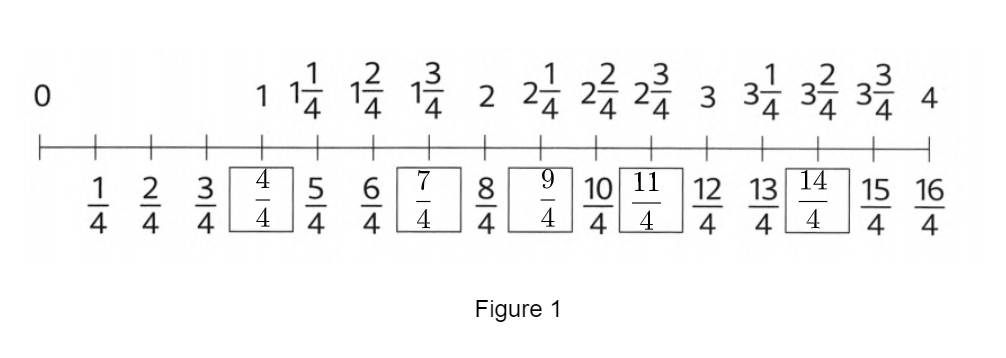
The figure filling each box with an improper fraction is given as-
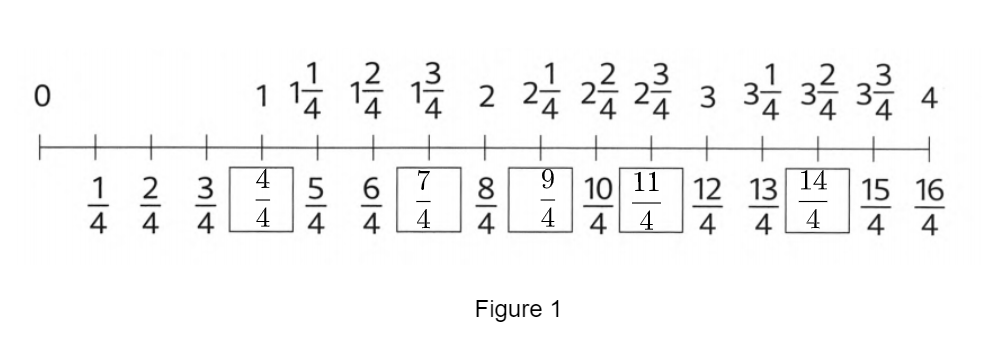
Page 103 Exercise 3.8 Problem 18
Given:
Various mixed fractions.
To match equal fractions after converting these mixed fractions into standard form.
Firstly, Convert all mixed fractions into standard form.
Then, match equal fractions with each other.
Finally, represent this in a figure.
From the figure given mixed fractions are-
\(1 \frac{1}{9}, 1 \frac{1}{8}, 1 \frac{1}{7}, 1 \frac{1}{6}, 1 \frac{1}{5}, 1 \frac{1}{4}, 1 \frac{1}{3}\)
And \(2 \frac{2}{3}, 2 \frac{1}{2}, 1 \frac{3}{4}, 2 \frac{1}{5}, 1 \frac{5}{6}, 1 \frac{7}{8}\)
These fraction in improper fraction are as follows-
1\(\frac{1}{9}\)= \(\frac{10}{9}\)
1\(\frac{1}{8}\)= \(\frac{9}{8}\)
1\(\frac{1}{7}\)= \(\frac{8}{7}\)
1\(\frac{1}{6}\)= \(\frac{7}{6}\)
And
1\(\frac{1}{5}\)= \(\frac{6}{5}\)
1\(\frac{1}{4}\)= \(\frac{5}{4}\)
1\(\frac{1}{3}\)=\(\frac{4}{3}\)
Remaining are-
2\(\frac{2}{3}\)= \(\frac{8}{3}\)
2\(\frac{1}{2}\)= \(\frac{5}{2}\)
1\(\frac{3}{4}\)=\(\frac{7}{4}\)
2\(\frac{1}{5}\)= \(\frac{11}{5}\)
And
1\(\frac{5}{6}\)= \(\frac{11}{5}\)
1\(\frac{7}{8}\)= \(\frac{15}{8}\)
Matching equal fractions in the figure –
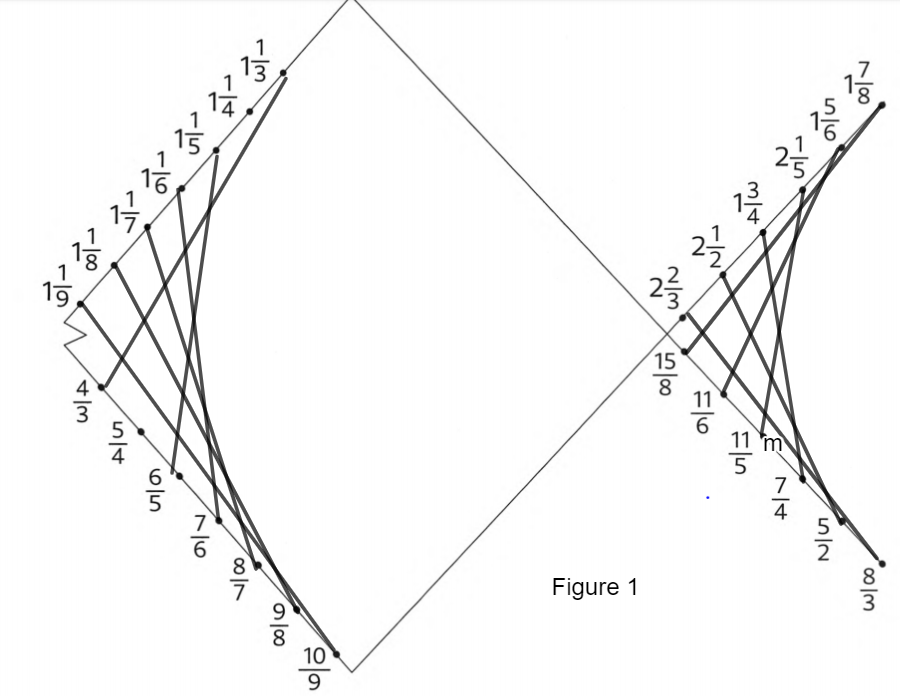
The figure joining equal fractions is as follows-
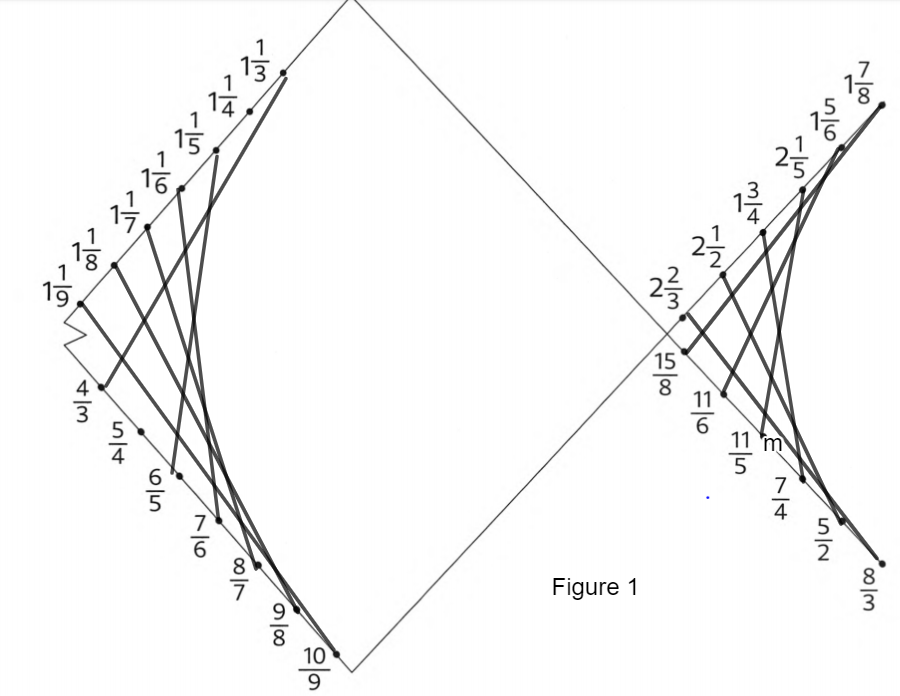
Page 104 Exercise3.8 Problem 19
Given:
Various mixed fractions.
To match equal fractions after converting these mixed fractions into standard form such that animals can be trapped.
Firstly, Convert all mixed fractions into standard form.
Then, match equal fractions with each other.
Finally, represent this so that animals can be trapped.
From figure given mixed fractions are-
\(3 \frac{7}{4}, 3 \frac{1}{2}, 2 \frac{2}{5}, 2 \frac{1}{3}, 3 \frac{1}{4}, 4 \frac{1}{6}, 1 \frac{4}{3}, 2 \frac{3}{2}, 4 \frac{3}{4}, 3 \frac{7}{6}, 2 \frac{5}{4}, 1 1 \frac{7}{5}\)
These fractions in improper fraction are as follows-
\(3 \frac{7}{4}\)= \(\frac{19}{4}\)
\(3 \frac{1}{2}\)=\(\frac{7}{2}\)
\( 2 \frac{2}{5}\)=\(\frac{12}{5}\)
\( 2 \frac{1}{3}\)=\(\frac{7}{3}\)
\( 3 \frac{1}{4}\)=\(\frac{13}{4}\)
\( 4 \frac{1}{6}\)=\( \frac{25}{6}\)
\( 1 \frac{4}{3}\)=\(\frac{7}{3}\)
\(2 \frac{3}{2}\)=\(\frac{7}{2}\)
Remaining are-
\(4 \frac{3}{4}\)=\(\frac{19}{4}\)
\(3 \frac{7}{6}\)=\(\frac{25}{6}\)
\(2 \frac{5}{4}\)=\(\frac{13}{4}\)
\(1 \frac{7}{5}\)=\(\frac{12}{5}\)
Thus, after converting from mixed fraction to improper fraction equal values are-
\(2 \frac{3}{2}\)=\(3 \frac{1}{2}\)=\(\frac{7}{2}\)
\( 2 \frac{2}{5}\)=\(1 \frac{7}{5}\)=\(\frac{12}{5}\)
\( 1 \frac{4}{3}\)=\( 2 \frac{1}{3}\)=\(\frac{7}{3}\)
\(2 \frac{5}{4}\)=\( 3 \frac{1}{4}\) =\(\frac{13}{4}\)
And
\(3 \frac{7}{6}\)=\( 4 \frac{1}{6}\)=\(\frac{25}{6}\)
\(4 \frac{3}{4}\)=\(3 \frac{7}{4}\)=\(\frac{19}{4}\)
Matching equal fractions in the figure –

The figure joining equal fractions such that animals are trapped is as follows-
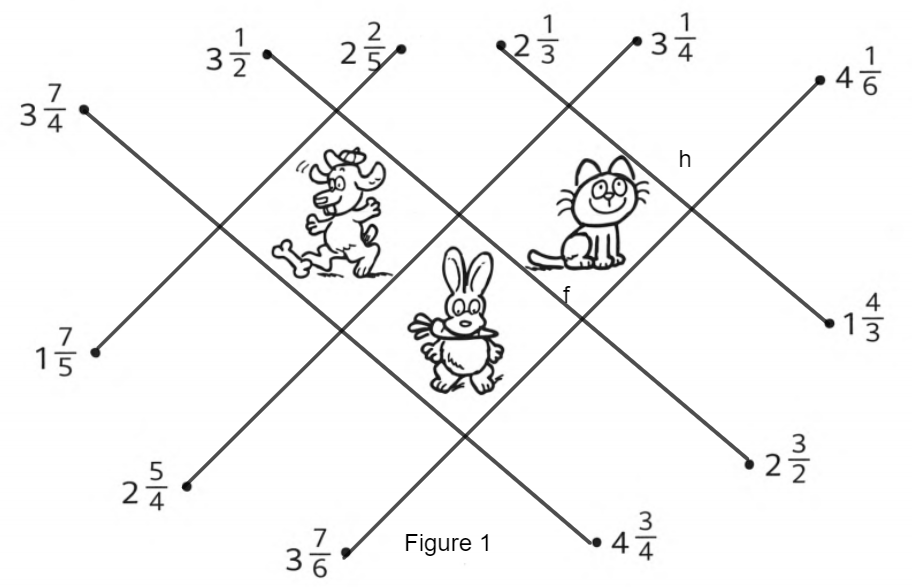
Page 105 Exercise 3.9 Problem 1
We are asked to convert the given figure into an improper fraction.
As it is given 3 full circles with 2 parts equally.
We have 1 Full circle and then we have a half circle which implies
= 1+ \(\frac{1}{2}\)
= \(\frac{3}{2}\)
Therefore, by converting the given figure into the improper fraction, we get \(\frac{3}{2}\).
Page 105 Exercise 3.9 Problem 2
We are asked to convert the given figure into an improper fraction.
As it is given 5 full circles with 3 parts equally.
We have 1 full circle and then one circle with 3 parts which implies
= 1+ \(\frac{2}{3}\)
= \(\frac{5}{3}\)
Therefore, by converting the given figure into the improper fraction, we get \(\frac{5}{3}\).
We are asked to convert the given figure into an improper fraction.
As it is given 7 full circl es with 4 parts equally.
We have 1 full circle and then one circle with 3 parts which implies
=1+ \(\frac{3}{4}\)
=\(\frac{7}{4}\)
Therefore, by converting the given figure into the improper fraction, we get \(\frac{7}{4}\)
Page 106 Exercise 3.9 Problem 3
We are given to convert given improper fraction into mixed fraction.
Given – \(\frac{8}{3}\)
To con- vert an improper fraction into mixed fraction let us divide the given fraction and then we have to write the divisor as whole number and quotient as the numerator and remainder as the denominator.
So, for 8÷3 we get 2 as quotient and 2 as remainder.
So, Mixed fraction = 3\(\frac{2}{2}\)
Therefore, by converting the improper fraction into mixed fraction we get 3\(\frac{2}{2}\)
Page 106 Exercise 3.9 Problem 4
We are given to convert given improper fractions into a mixed fraction.
Given – \(\frac{10}{3}\)
To convert improper fractions into mixed fractions let us divide the given fraction and then we have to write the divisor as whole number and quotient as the numerator and the remainder as the numerator.
So, for 10 ÷ 3 we get 3 as quotient and 1 as remainder.
So, Mixed fraction = 3\(\frac{1}{3}\).
Therefore, by converting the improper fraction into mixed fraction we get 3\(\frac{1}{3}\)
Page 106 Exercise 3.9 Problem 5
We are given to convert given improper fractions into a mixed fraction.
Given – \(\frac{12}{5}\)
To convert improper fractions into mixed fractions let us divide the given fraction and then we have to write the divisor as whole number and quotient as the numerator and remainder as numerator.
So, for 12÷5 we get 3 as quotient and 2 as remainder.
So, Mixed fraction = 2\(\frac{2}{5}\).
Therefore, by converting the improper fraction into mixed fraction we get 2\(\frac{2}{5}\)
Page 106 Exercise 3.9 Problem 6
We are given to convert given improper fraction into a mixed fraction.
Given – \(\frac{11}{4}\)
To convert improper fractions into mixed fractions let us divide the given fraction and then we have to write the divisor as whole number and quotient as the numerator and the remainder as the numerator.
So, for 11÷4 we get 2 as quotient and 3 as remainder.
So, Mixed fraction = 2 \(\frac{3}{4}\).
Therefore, by converting the improper fraction into mixed fraction we get \(\frac{3}{4}\)
Page 106 Exercise 3.9 Problem 7
We are given an improper fraction to convert into mixed fraction or a whole number.
Given – \(\frac{8}{2}\).
As we- can see that 8 is divisible by 2 at 4th time.
So, \(\frac{8}{2}\) is 4.
Therefore, we can say that by converting \(\frac{8}{2}\) into whole number we get.
Page 106 Exercise 3.9 Problem 8
We are given to convert given improper fractions into a mixed fractions or whole numbers.
Given – \(\frac{11}{5}\)
To convert improper fractions into mixed fractions let us divide the given fraction and then we have to write the divisor as whole number and quotient as the numerator and the remainder as the numerator.
So, fo – r 11÷5 we get 2 as quotient and 1 as remainder.
So, Mixed fraction = 2\(\frac{1}{5}\).
Therefore, by converting the improper fraction into a mixed fraction we get 2\(\frac{1}{5}\).
Page 106 Exercise 3.9 Problem 9
We are given to convert given improper fractions into mixed fractions or whole numbers.
Given – 2 \(\frac{17}{8}\)
To convert improper fractions into mixed fractions let us divide the given fraction and then we have to write the divisor as whole number and quotient as the numerator and the remainder as the numerator.
So, for 17÷8 we get 2 as quotient and 1 as remainder.
So, Mixed fraction = 2 \(\frac{1}{8}\).
Therefore, by converting the improper fraction into mixed fraction we get2 \(\frac{1}{8}\).
Page 106 Exercise 3.9 Problem 10
We are given an improper fraction to convert into mixed fraction or a whole number.
Given – \(\frac{27}{3}\).
As we can see that 27 is divisible by 3 at 9th time.
So,\(\frac{27}{3}\) is 9.
Therefore, we can say that by converting \(\frac{27}{3}\) into whole number we get 9.
